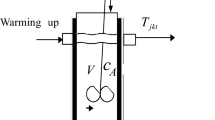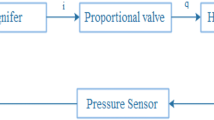Abstract
This paper proposes a particle swarm optimization (PSO) tuned novel proportional integral derivative (PID) like neural network (PSO-PID-NN), to control the temperature of a nonlinear jacketed continuous stirred tank reactor (CSTR). The nonlinear continuous stirred tank reactor (CSTR) plant is one of the most popular reactors in the chemical industry. The proposed structure is elegant in design, having only three neurons in the hidden layer and a single output neuron. The three weights in the neural network's output layer represent the PID controller's proportional, integral, and derivative gains. The suggested approach uses the PSO method to optimize the output layer weights, which corresponds to the PID gains. Mean square error is used as an objective function to optimize the weights. The performance of the proposed PSO-PID-NN controller is tested by comparing the time domain specifications of the output response, against the conventional Zeigler Nichols tuned PID controller and the back propagation-based NN-PID controller (BP-NN-PID). The overshoot in the proposed controller is 23.13%, while it is 26.33% in BP-NN-PID, and 44.13% in Zeigler Nichols tuned PID controller. In addition, the rise time is 0.1283 s, while it is 0.2727 s in the BP-NN-PID controller and 0.2813 s in Zeigler Nichols tuned PID controller. The proposed controller is also tested for disturbance rejection, it was found to be more efficient in rejecting disturbance signals as compared to BP-NN-PID and ZN-tuned PID controllers.












Similar content being viewed by others
Data Availability
No data set was used in the present research.
References
1-0-1-k-j-astrom-pid-controllers-theory-design-and-tuning-2ed.pdf
Cohen GH, Coon GA (1953) Theoretical consideration of related control. Trans ASME 75:827–834. https://doi.org/10.1115/1.4015451
Agalya A, Nagaraj B (2013) Certain investigation on concentration control of CSTR—a comparative approach. Int J Adv Soft Comput Appl 5(2):1–14
Al-qaness MAA, Helmi AM, Dahou A, Elaziz MA (2022a) The applications of metaheuristics for human activity recognition and fall detection using wearable sensors: a comprehensive analysis. Biosensors (basel) 12(10):1–21. https://doi.org/10.3390/bios12100821
Al-qaness MAA, Ewees AA, Abualigah L, AlRassas AM, Thanh HV, Abd Elaziz M (2022b) Evaluating the applications of dendritic neuron model with metaheuristic optimization algorithms for crude-oil-production forecasting. Entropy 24(11):1–14. https://doi.org/10.3390/e24111674
Al-qaness MAA, Ewees AA, Thanh HV, AlRassas AM, Dahou A, Elaziz MA (2023a) Predicting CO2 trapping in deep saline aquifers using optimized long short-term memory. Environ Sci Pollut Res 30(12):33780–33794. https://doi.org/10.1007/s11356-022-24326-5
Al-qaness MAA, Ewees AA, Fan H, Abualigah L, Elsheikh AH, Abd Elaziz M (2023b) Wind power prediction using random vector functional link network with capuchin search algorithm. Ain Shams Eng J 14(9):102095. https://doi.org/10.1016/j.asej.2022.102095
Arrif T, Hassani S, Guermoui M, Sánchez-González A, Taylor RA, Belaid A (2022) GA-GOA hybrid algorithm and comparative study of different metaheuristic population-based algorithms for solar tower heliostat field design. Renew Energy 192:745–758. https://doi.org/10.1016/J.RENENE.2022.04.162
Bingul Z, Karahan O (2018) Comparison of PID and FOPID controllers tuned by PSO and ABC algorithms for unstable and integrating systems with time delay. Optim Control Appl Methods 39(4):1431–1450. https://doi.org/10.1002/oca.2419
Chatterjee S, Mukherjee V (2016) PID controller for automatic voltage regulator using teaching-learning based optimization technique. Int J Electr Power Energy Syst 77:418–429. https://doi.org/10.1016/j.ijepes.2015.11.010
Deepa SN, Baranilingesan I (2018) Optimized deep learning neural network predictive controller for continuous stirred tank reactor. Comput Electr Eng 71:782–797. https://doi.org/10.1016/j.compeleceng.2017.07.004
Deepa SN, Jayalakshmi NY (2023) Optimized fuzzy-based wavelet neural network controller for a non-linear process control system. IETE J Res 69(3):1363–1372. https://doi.org/10.1080/03772063.2020.1865212
Jalali N, Razmi H, Doagou-Mojarrad H (2020) Optimized fuzzy self-tuning PID controller design based on Tribe-DE optimization algorithm and rule weight adjustment method for load frequency control of interconnected multi-area power systems. Appl Soft Comput 93:106424. https://doi.org/10.1016/J.ASOC.2020.106424
Kalita P, Barman JK (2017) Performance analysis of non-linear jacketed CSTR based on different control strategies. ADBU J Electr Electron Eng (AJEEE) 1(2):1–7
Kaveh A, Khavaninzadeh N (2023) Efficient training of two ANNs using four meta-heuristic algorithms for predicting the FRP strength. Structures 52:256–272. https://doi.org/10.1016/J.ISTRUC.2023.03.178
Kazemian HB (2005) Developments of fuzzy PID controllers. Expert Syst 22(5):254–264. https://doi.org/10.1111/j.1468-0394.2005.00316.x
Khanduja N, Bhushan B (2021) Optimal design of FOPID controller for the control of CSTR by using a novel hybrid metaheuristic algorithm. Sadhana Acad Proc Eng Sci. https://doi.org/10.1007/s12046-021-01632-1
Khanduja N, Bhushan B, Mishra S (2020) Control of CSTR using firefly and hybrid firefly-biogeography based optimization (BBFFO) algorithm. J Inf Optim Sci 41(6):1443–1452. https://doi.org/10.1080/02522667.2020.1809098
Kumar R, Srivastava S, Gupta JRP (2017) Artificial neural network based PID controller for online control of dynamical systems. In: 1st IEEE international conference on power electronics, intelligent control and energy systems, ICPEICES 2016, pp 1–6, 2017. https://doi.org/10.1109/ICPEICES.2016.7853092
Lins AW, Krishnakumar R (2022) Tuning of PID controller for a PV-fed BLDC motor using PSO and TLBO algorithm. Appl Nanosci (switzerland). https://doi.org/10.1007/s13204-021-02272-x
Rajesh R (2019) Optimal tuning of FOPID controller based on PSO algorithm with reference model for a single conical tank system. SN Appl Sci 1(7):1–14. https://doi.org/10.1007/s42452-019-0754-3
Rao RV, Savsani VJ, Vakharia DP (2011) Teaching-learning-based optimization: a novel method for constrained mechanical design optimization problems. CAD Comput Aided Des 43(3):303–315. https://doi.org/10.1016/j.cad.2010.12.015
Ribeiro JMS, Santos MF, Carmo MJ, Silva MF (2017) Comparison of PID controller tuning methods: analytical/classical techniques versus optimization algorithms. In: 2017 18th International Carpathian Control Conference (ICCC), pp 533–538. https://doi.org/10.1109/CARPATHIANCC.2017.7970458
Sharma A, Fikar M, Bakošová M (2015) Comparative study of time optimal controller with PID controller for a continuous stirred tank reactor. Acta Chim Slov 8(1):27–33. https://doi.org/10.1515/acs-2015-0006
Singh A, Sharma V (2013) Concentration control of CSTR through fractional order PID controller by using soft techniques. In: 2013 4th international conference on computing, communications and networking technologies, ICCCNT 2013. https://doi.org/10.1109/ICCCNT.2013.6726501
Sivaramakrishnan N, Hemavathy PR, Anitha G (2017) Design of hybrid control for isothermal continuous stirred tank reactor. Int J Pure Appl Math 117(December):999–1009
Somefun OA, Akingbade K, Dahunsi F (2021) The dilemma of PID tuning. Annu Rev Control 52:65–74. https://doi.org/10.1016/j.arcontrol.2021.05.002
Soukkou A, Khellaf A, Leulmi S, Boudeghdegh K (2008) Optimal control of a CSTR process. Braz J Chem Eng 25(4):799–812. https://doi.org/10.1590/S0104-66322008000400017
Tang G, Lei J, Du H, Yao B, Zhu W, Hu X (2022) Proportional-integral-derivative controller optimization by particle swarm optimization and back propagation neural network for a parallel stabilized platform in marine operations. J Ocean Eng Sci. https://doi.org/10.1016/j.joes.2022.05.015
Wallam F, Memon AY (2017) A robust control scheme for nonlinear non-isothermal uncertain jacketed continuous stirred tank reactor. J Process Control 51:55–67. https://doi.org/10.1016/J.JPROCONT.2016.11.001
Wu Y, Wei Y, An D, Liu J (2023) A hybrid control strategy based on neural network and PID for underwater robot hovering, pp 1843–1848. https://doi.org/10.1109/cscwd57460.2023.10152857
Yang R, Liu Y, Yu Y, He X, Li H (2021) Hybrid improved particle swarm optimization-cuckoo search optimized fuzzy PID controller for micro gas turbine. Energy Rep 7:5446–5454. https://doi.org/10.1016/J.EGYR.2021.08.120
Zeng GQ, Xie XQ, Chen MR, Weng J (2019) Adaptive population extremal optimization-based PID neural network for multivariable nonlinear control systems. Swarm Evol Comput 44:320–334. https://doi.org/10.1016/j.swevo.2018.04.008
Zhang Y, Xiao X (2023) Fuzzy PID control system optimization and verification for oxygen-supplying management in live fish waterless transportation. Inf Process Agric. https://doi.org/10.1016/J.INPA.2023.06.001
Zhang J, Zhuang J, Du H, Wang S (2009) Self-organizing genetic algorithm based tuning of PID controllers. Inf Sci (n Y) 179(7):1007–1018. https://doi.org/10.1016/J.INS.2008.11.038
Zhang L, Li S, Xue Y, Zhou H, Ren Z (2022) Neural network PID control for combustion instability. Combust Theor Model. https://doi.org/10.1080/13647830.2022.2025908
Ziegler JG, Nichols NB (1942) Optimum Settings for Automatic Controllers. Trans ASME 64:759–768
Funding
The authors declare that no funds, grants, or other support were received during the preparation of this manuscript.
Author information
Authors and Affiliations
Contributions
All authors have contributed significantly to the study. The study conception and design were performed by SC and NK. Analysis and interpretation of results were done by RK. Draft manuscript preparation was done by SC, NK and RK. All authors reviewed the results and approved the final version of the manuscript.
Corresponding author
Ethics declarations
Conflict of interest
The authors certify that there is no conflict of interest with any individual/organization for the present work.
Ethical approval
Not applicable.
Informed consent
Not applicable.
Additional information
Publisher's Note
Springer Nature remains neutral with regard to jurisdictional claims in published maps and institutional affiliations.
Rights and permissions
Springer Nature or its licensor (e.g. a society or other partner) holds exclusive rights to this article under a publishing agreement with the author(s) or other rightsholder(s); author self-archiving of the accepted manuscript version of this article is solely governed by the terms of such publishing agreement and applicable law.
About this article
Cite this article
Chaturvedi, S., Kumar, N. & Kumar, R. A PSO-optimized novel PID neural network model for temperature control of jacketed CSTR: design, simulation, and a comparative study. Soft Comput 28, 4759–4773 (2024). https://doi.org/10.1007/s00500-023-09138-0
Accepted:
Published:
Issue Date:
DOI: https://doi.org/10.1007/s00500-023-09138-0




